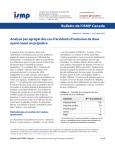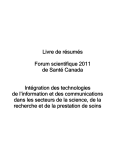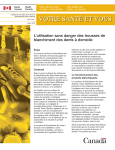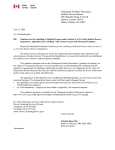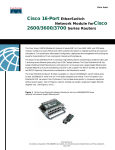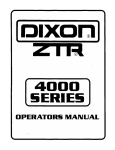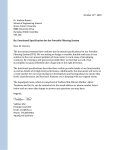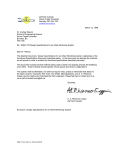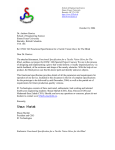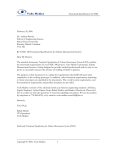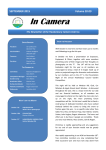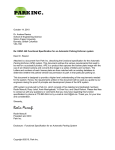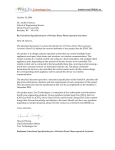Download Functional Specifications for an automated snowboard binding
Transcript
8888 University Drive, Burnaby BC Canada [email protected] February 16, 2011 Dr. Andrew Rawicz School Of Engineering Science Simon Fraser University Burnaby, British Columbia V5A 1S6 Re: ENSC 440 Functional Specifications: Auto Secure Binding - An Automated Snowboard Binding System by JAC Innovations Ltd. Dear Dr. Rawicz, Please find enclosed the functional specifications for the Auto-Secure Bindings (ASB) from JAC Innovations. We are further improving snowboarding bindings by designing and implementing a complete automated snowboard binding system. The ASB aims to provide snowboarders of all ages and skill-levels convenience and avant-garde style to the snowboarding experience. The functional specifications present the set of high-level specifications required for the ASB’s functionality throughout its various phases of development. This document will provide the baseline requirements for the prototype version of the ASB. The design team at JAC Innovations will make reference to this document to ensure that the ASB operates satisfactorily. JAC Innovations consists of five motivated and knowledgeable fifth-year engineering students: Clara Luo, Andrew Ng, Jackie Ng, Jeffrey Sun, and Jacky Wong. These five individuals bring their experience in software engineering, hardware fabrication, and telecommunications to the team. If you have any inquiries or comments regarding our project, please feel free to contact our team via e-mail at [email protected]. Alternatively, you may contact me directly by e-mail at [email protected] or by telephone at 604-751-5556. Sincerely, Jacky Wong Chief Executive Officer JAC Innovations Ltd. Enclosed: Functional Specs for Auto-Secure Bindings - An Automated Snowboard Binding System Functional Specifications for an automated snowboard binding securing system Project Team: Clara Luo Andrew Ng Jackie Ng Jeffrey Sun Jacky Wong Team Contact: [email protected] Document Created: February 8th, 2011 Document Revised: February 15th, 2011 Submitted to: Dr. Andrew Rawicz Michael Sjoerdsma School of Engineering Science Simon Fraser University Functional Specification for Auto-Secure Bindings An Automated Snowboard Binding System Executive Summary Snowboarding is an incredible winter sport, it’s fast, exhilarating, and thrilling but it’s also physically demanding. Time and energy should not be wasted on fumbling with snowboarding bindings. The Auto-Secure Bindings (ASB) provides an elegant solution and makes the most out of the snowboarding experience. The ASB is an automated, easy-to-use, and efficient snowboard binding system. Note that the ASB is not an add-on upgrade product for existing snowboard bindings, it is a standalone system. Hence, the ASB is comprised of two units: a pair of automated snowboard bindings and a wireless remote controller. The pair of automated snowboard bindings is an improved hybrid design from all current types of bindings. Motors and specialized locking ratchet joints facilitate in tightening and holding the user’s snowboarding boot in place while riding down the mountain. The bindings will receive signals from the remote controller to perform its various automated functions. The wireless remote controller is a small handheld device with tactile buttons. The remote control will transmit commands to the snowboard bindings and the user can store the controller within their pockets when not in use. The functional specifications that are covered in this document are designed and implemented for the primary prototype version of the ASB. Further prototype iterations will strive to reduce size, weight, aesthetics, and energy consumption. As well, additional advanced remote control functionality will be considered such as chronograph capabilities, speed and altitude statistics, map features, and GPS tracking. Since snowboarding is a high speed activity, safety is a greatly prevalent factor. The prototype must meet the stringent safety specifications outlined in this document. Furthermore, the ASB will comply with ISO 10958, ISO 14573, and ISO 22264 snowboarding equipment standards. JAC Innovations pledges to only create safe, efficient, user-friendly, and indisputably, innovative designs. ©2011 JAC Innovation Inc. i Functional Specification for Auto-Secure Bindings An Automated Snowboard Binding System Table of Contents Executive Summary........................................................................................................................................ i List of Tables ................................................................................................................................................ iv List of Figures ............................................................................................................................................... iv Glossary ......................................................................................................................................................... 1 Introduction .................................................................................................................................................. 2 Scope ......................................................................................................................................................... 2 Intended Audience .................................................................................................................................... 2 Functional Requirement Convention ........................................................................................................ 3 System Overview .......................................................................................................................................... 4 Entire System ................................................................................................................................................ 6 General Requirements .............................................................................................................................. 6 Physical Requirements .............................................................................................................................. 6 Mechanical Requirements ........................................................................................................................ 6 Environment Requirements ...................................................................................................................... 6 Reliability and Durability ........................................................................................................................... 6 Safety Requirements ................................................................................................................................. 6 Standard .................................................................................................................................................... 6 Wireless Control Unit .................................................................................................................................... 7 Usability Requirements ............................................................................................................................. 7 Safety Requirements ................................................................................................................................. 7 Environment Requirements ...................................................................................................................... 7 Physical Requirements .............................................................................................................................. 7 Electrical Requirements ............................................................................................................................ 7 Performance Requirements ...................................................................................................................... 7 Reliability and Durability ........................................................................................................................... 7 Binding Unit .................................................................................................................................................. 7 General Requirements .............................................................................................................................. 7 Mechanical Requirements ........................................................................................................................ 8 Reliability and Durability ........................................................................................................................... 8 Performance Requirements ...................................................................................................................... 8 ©2011 JAC Innovation Inc. ii Functional Specification for Auto-Secure Bindings An Automated Snowboard Binding System Electrical Performance .............................................................................................................................. 8 Safety Requirement .................................................................................................................................. 8 Performance Requirement ....................................................................................................................... 8 Luxury Functions ....................................................................................................................................... 8 User Documentation and Training ................................................................................................................ 8 System Test Plan ........................................................................................................................................... 9 Individual Component Testing .................................................................................................................. 9 Integration Testing .................................................................................................................................. 10 Qualitative Testing .................................................................................................................................. 10 Failure Testing ......................................................................................................................................... 10 Conclusion ................................................................................................................................................... 11 References .................................................................................................................................................. 12 ©2011 JAC Innovation Inc. iii Functional Specification for Auto-Secure Bindings An Automated Snowboard Binding System List of Tables Table 1 - Description of functional requirement priority level ..................................................................... 3 List of Figures Figure 1 - System overview of Auto Secure Bindings.................................................................................... 4 Figure 2 - An overview of binding unit with hinges and securing bracket.................................................... 5 ©2011 JAC Innovation Inc. iv Functional Specification for Auto-Secure Bindings An Automated Snowboard Binding System Glossary ASB MCU MTTF MSRP RF Auto Secure Binding Micro-Controller Unit Mean Time To Failure Manufacturer Suggested Retail Price Radio Frequency ©2011 JAC Innovation Inc. 1 Functional Specification for Auto-Secure Bindings An Automated Snowboard Binding System Introduction The Auto Secure Bindings (ASB) is a highly sophisticated electro-mechanical snowboard binding system which will greatly enhance the snowboard rider’s experience and pleasure. This product is a dual unit system which contains a user-friendly wireless controller and a pair of motorized binding mounted on a snowboard. The wireless control unit is responsible for transmitting a signal to the binding securing unit via RF communication. The binding unit is responsible for the securing and releasing mechanism of the binding upon receiving the signal from the wireless controller. Together, the ASB combines the current binding styles with mechanical and electrical components to provide a fully automated snowboard binding system. The detailed functional requirements for the ASB are described in this documentation. Scope The objective of this document is to outline and detail the functional requirements that must be met by the ASB. These documented specifications fully describe the functionalities of the proof-of-concept and prototype system and to some extent describe the retail version of the system in detail. Possible design modifications and optional features of future implementation will also be mentioned in the document. The discussion of low level implementation methods to achieve the required specifications will be out of the scope of this document. Intended Audience The document is intended to act as a reference and printed transcript for various parties of JAC Innovations. The functional specification ensures all designers and engineers implement decisions which conform to the intended functionalities of the device during research & developing, prototyping, and optimization cycle of the production. The project manager can easily refer to this document to organize the development and milestones during the development and production process. This document will serve the guideline for management to keep the project on track and on schedule. The marketing team can refer to this document to develop marketing strategies and materials needed to promote the device in the market. This document provides assistance to marketing to identify the advantages of the product over competitor’s product and position the product in the market accordingly to increase market share percentage. ©2011 JAC Innovation Inc. 2 Functional Specification for Auto-Secure Bindings An Automated Snowboard Binding System Functional Requirement Convention In this document, the following convention shall be used to differentiate between different categories of important functional requirements: [FR-###-P] Where, Functional specification description. FR = Functional Requirement ### = Functional requirement identification number P = Functional requirement priority level: 1, 2, 3 Table 1 below specifies the description of each priority level. Table 1 - Description of functional requirement priority level Priority Level 1 2 3 Description Implies that the requirement applies merely to the proof-of-concept system Implies that the requirement applies to both proof-of-concept system and the production system Implies that the requirement applies to only the production system ©2011 JAC Innovation Inc. 3 Functional Specification for Auto-Secure Bindings An Automated Snowboard Binding System System Overview The system overview of Auto Secure Bindings is given in Figure 1. Figure 1 - System overview of Auto Secure Bindings ©2011 JAC Innovation Inc. 4 Functional Specification for Auto-Secure Bindings An Automated Snowboard Binding System The ASB is a revolutionary automated snowboarding binding system which consists of two major units the binding unit and wireless control unit. The two units communicate via 2.4Ghz RF, which has a working range up to 120m, and there will be one RF transceiver module locate on each unit as illustrated in Figure 1. The ASB allows the user to control the securing mechanism of the right and left bindings individually. The binding unit consists of a MCU which interprets the signals received from the wireless controller and it controls the corresponding mechanical system to actuate the binding(s). The bindings are initially in the open position so that the user can easily step into the apparatus. To secure the boot, a sturdy metal frame closes and applies pressure to the boot. There will be a total of two motors driving each binding, the front bracket and the back-plate. The front bracket will be mounted on two ratchet hinges and the front motor is responsible for actuating them. Similarly, the back-plate will be mounted onto two ratchet hinges at the rear of the binding. The actuation of this component is controlled by the rear motor. Figure 2 below should clarify the moving mechanism of the binding unit. Figure 2 - An overview of binding unit with hinges and securing bracket On the other hand, the wireless controller of ASB acts as the base station to manipulate the bindings. The snowboard rider simply presses the corresponding button to actuate the binding. The binding’s MCU is able to memorize the user’s previous configuration. ©2011 JAC Innovation Inc. 5 Functional Specification for Auto-Secure Bindings An Automated Snowboard Binding System Entire System General Requirements [FR-001-1] [FR-002-2] [FR-003-1] The system cost shall be under MSRP of $800. The system shall secure the communication protocol from outside interference. The system’s primary and sole mean of input shall be a set of buttons. Physical Requirements [FR-004-2] [FR-005-3] [FR-006-2] The system shall be water-proof and shock-proof. The system shall be compatible with different brand of soft snowboarding boots. The mechanical and electronic components shall be enclosed in a waterproof casing. Mechanical Requirements [FR-007-2] The system shall be able to secure the boot tightly according to user’s preset. Environment Requirements [FR-008-3] [FR-009-3] [FR-010-3] The system shall perform under extreme wet and/or cold condition. The system shall be able to operate from zero to 5000 meters above sea level. The system shall be able to operate at zero to 90 percent humidity. Reliability and Durability [FR-011-2] [FR-012-2] [FR-013-2] [FR-014-3] [FR-015-3] [FR-016-3] [FR-017-3] The system firmware shall upgradable by a service-person. The system shall be able to withstand constant physical duress. The system shall resist breakage under normal operating conditions. The system shall resist failure from water, snow, and ice. The MTTF shall be no less than 3 years. The system shall not require regular service. All of the device components shall have a duty cycle of at least 1,000,000 cycles. Safety Requirements [FR-018-2] The system should not overheat and/or combust. Standard [FR-019-3] [FR-020-3] [FR-021-3] [FR-022-3] [FR-023-3] Adhere to ISO 14573:2002 standard for the proper snowboard binding classification. [1] Adhere to ISO 15344:2005 standard for Snowboard step-in binding [2] Adhere to ISO 10958:2001 standard for the Binding mounting area [3] Adhere to Radiation Protection Bureau of Health Canada regulation [4] Adhere to Canada’s Safety Code 6 RF Standard, communicate using RF range below 3GHz [5] ©2011 JAC Innovation Inc. 6 Functional Specification for Auto-Secure Bindings An Automated Snowboard Binding System Wireless Control Unit Usability Requirements [FR-024-2] [FR-025-2] [FR-026-3] The remote control shall possess indicator LEDs for different states. The user interface shall be intuitive and easy to use. They remote control shall communicate at a distance range of at least 2 meters. Safety Requirements [FR-027-3] The remote control shall communicate with encrypted communication signals. Environment Requirements [FR-028-3] The remote control should remain functional at -20℃. Physical Requirements [FR-029-2] [FR-030-2] [FR-031-2] The remote control shall provide user feedback for button depression. The remote control shall physically prevent sending any signal accidentally. The battery shall be accessible and changeable. Electrical Requirements [FR-032-1] The power is supplied by a single 9V battery Performance Requirements [FR-033-2] The remote controller shall start up within 500 milliseconds. Reliability and Durability [FR-034-2] The remote controller shall withstand a fall of 2 meters. Binding Unit General Requirements [FR-035-2] [FR-036-2] [FR-037-2] [FR-038-2] [FR-039-3] [FR-040-1] The binding shall open automatically upon request from the remote controller. The bindings shall automatically tighten when the user’s boot is detected on the base. The bindings shall tighten and loosen upon request from the remote controller. The bindings shall identify and separate the signal for left and right bindings. The binding system should not be intrusive to the user. The bindings should have an idle state where the components are static and locked. ©2011 JAC Innovation Inc. 7 Functional Specification for Auto-Secure Bindings An Automated Snowboard Binding System Mechanical Requirements [FR-041-2] [FR-042-2] [FR-043-2] [FR-044-3] The securing mechanism shall use adjustable locking joints. The back-plate shall lower to allow the user to step in. All automated parts shall be able to be manually adjusted. The unit shall not be physically obtrusive to the user. Reliability and Durability [FR-045-2] [FR-046-2] The unit shall withstand the force generated from the user’s feet against the back-plate. The unit shall endure the force generated from the user’s feet against the front bracket. Performance Requirements [FR-047-3] The bindings shall not exceed 4 kilograms. Electrical Performance [FR-048-2] [FR-049-3] [FR-050-1] [FR-051-3] [FR-052-2] [FR-053-2] The power supply shall be able to power all moving components simultaneously. The bindings shall enter a sleep mode to conserve power consumption. Key voltage nodes shall accessible for measurement and troubleshooting. The normal operation of the unit shall allow the power supply to last at least 3 months. The battery shall be accessible and changeable. There shall be a separate power source powering the motors. Safety Requirement [FR-054-2] The unit shall not cause bodily harm during adjust. Performance Requirement [FR-055-3] [FR-056-3] [FR-057-3] The bindings shall start up within 500 milliseconds. The binding shall respond to remote signals within one second The total time taken for automatic adjustment shall not exceed 30 seconds Luxury Functions [FR-058-3] [FR-059-3] The bindings shall have accessory lighting. The bindings shall be able to be customized with selective colours or patterns User Documentation and Training [FR-060-3] [FR-061-3] [FR-062-3] The user manual shall in a simple high level language. A detailed specification menu for service technician and vendors shall be created. User documentation shall have a user manual containing general and technical support information. ©2011 JAC Innovation Inc. 8 Functional Specification for Auto-Secure Bindings An Automated Snowboard Binding System System Test Plan The development of ASB will follow four in-depth testing stages. All units will undergo testing individually in the first testing cycle. To ensure the system is functioning properly, each component is required to meet its specifications. In the seconding testing stage, the units are integrated together and undergo functionality and compatibility testing as a whole. The next stage is to conduct qualitative testing, employing a systematic method involving typical user-scenarios. In the last testing stage, the system will be tested for catastrophic failures. Individual Component Testing In this testing cycle, each component is tested for its functionality. MCU: • • • • • Ability to establish two way communication between PC for programming and debugging Ability to execute software implemented flawlessly Ability to interpret RF signals received Ability to stay powered for extended periods of time without failure Ability to distribute signal to peripherals Ratchet Joints: • Ability to rotate up to 90o forward and backward • Ability to minimize backlash • Ability to rotate step by step Motor: • Ability to achieve required torque with supplied battery power RF Transceiver Module: • Ability to detect other RF modules in range • Ability to transfer data between RF modules • Ability to power up by battery pack Circuitry: • Ability to power unit via battery pack • Ability to store presets Buttons: • Ability to send out corresponding command assigned ©2011 JAC Innovation Inc. 9 Functional Specification for Auto-Secure Bindings An Automated Snowboard Binding System Integration Testing Binding Unit: • Ability to rotate the ratchet joint(s) forward and backward • Ability to secure the boot tightly according to user’s preset preference • Ability to loosen the boot mechanically • Ability to receive signals from wireless control unit • Ability to detect user’s boot Wireless Control Unit: • Ability to communicate with binding unit • Ability to response to user’s input • Ability to illuminate LED feedback Qualitative Testing Typical User –Scenarios: • User dropping the binding unit 2 meters above ground • User crushing the binding unit while stepping in • User loosening the binding unit manually • Minimizing actuating time • Volatile vibration • Operation in cold and humid condition Failure Testing Typical –improper use scenarios: • Place foreign objects into the binding unit • Wireless controller battery runs out • Binding unit battery runs out • Submersing system in water ©2011 JAC Innovation Inc. 10 Functional Specification for Auto-Secure Bindings An Automated Snowboard Binding System Conclusion The function specifications laid out in this document outlines the necessary requirements for the proofof-concept, prototype, and the final retail product. The proof-of-concept and prototype device are currently in development. The requirements for each phase are marked with set priorities which must be met. The prototype will be delivered in mid to late April. ©2011 JAC Innovation Inc. 11 Functional Specification for Auto-Secure Bindings An Automated Snowboard Binding System References [1] International Organization for Standard (2002, November). ISO 14573:2002 - Snowboard strap bindings for soft boots -- Requirements and test methods. Retrieved February 9, 2011 from http://www.iso.org/iso/iso_catalogue/catalogue_tc/catalogue_detail.htm?csnumber=24823 [2] International Organization for Standard (2005, September). ISO 15344:2005 - Snowboard step-in bindings -- Requirements and test methods. Retrieved February 9, 2011 from http://www.iso.org/iso/iso_catalogue/catalogue_tc/catalogue_detail.htm?csnumber=37520 [3] International Organization for Standard (2004, November). ISO 10958-2:2004 -Snowboards -- Binding mounting area -- Part 2: Requirements and test methods for snowboards with inserts. Retrieved February 9, 2011 from http://www.iso.org/iso/iso_catalogue/catalogue_tc/catalogue_detail.htm?csnumber=37795 [4] Health Canada (2011, February). Radiation Protection Bureau – Healthy Environments and Cnsumer Safety Branch – Health Canada. Retrieved February 11, 2011 from http://www.hc-sc.gc.ca/ahc-asc/branch-dirgen/hecs-dgsesc/sep-psm/rpb-br-eng.php [5] Health Canada (2009, March). Health Canada Safety Code 6 Standard_2009. Retrieved February 11, 2011 from http://rfsafetysolutions.com/PDF%20Files/Health%20Canada%20Safety%20Code%206%20Standard_20 09.pdf ©2011 JAC Innovation Inc. 12


















